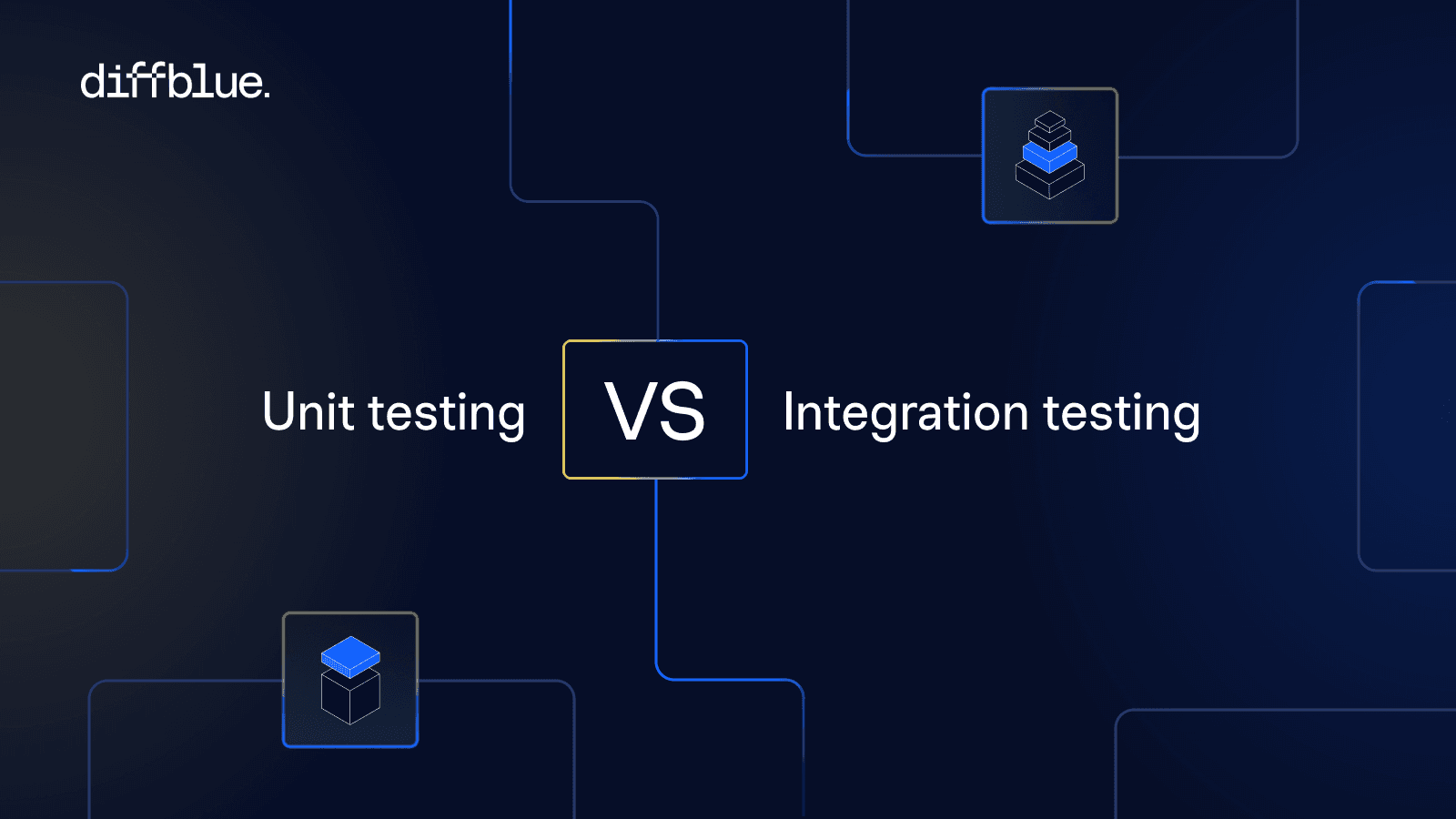Imagine pushing a code update that passes all your unit tests – only to see your application break because two components aren’t communicating correctly in production. This scenario underscores the importance of both unit testing and integration testing in software development.
While these two types of testing aim to ensure software quality, they serve distinct purposes. Understanding the difference between unit testing and integration testing is essential for building reliable software; it’s not a question of unit test vs integration test, but how to use both effectively in tandem. In this guide, we’ll explore both types of testing with practical examples of unit testing and integration testing in Java, when to use each, how unit and integration testing fit into the testing pyramid, and how tools like JUnit, Spring Boot, and Diffblue Cover support modern testing workflows.
What is Unit Testing?
Unit testing is the process of testing individual units of code — typically a single method or class — in isolation. The goal is to verify that each unit performs as expected, without being influenced by external systems such as databases or APIs.
Unit testing is most commonly a form of white-box testing, written and run by developers during development. Test doubles, such as mocks and stubs, are used to simulate dependencies so tests can focus strictly on the code being tested.
Example – unit test in Java (JUnit 5):
class TaxCalculatorTest {
@Test
void calculateTax_returnsCorrectValue() {
TaxCalculator calc = new TaxCalculator();
double result = calc.calculateTax(100.0);
assertEquals(15.0, result, 0.001); // assuming 15% tax rate
}
}This test checks the correctness of the calculateTax() method without involving any external components.
👉 Related: Java Unit Testing: A Complete Guide for Developers
What is integration testing?
Integration testing tests how multiple units or modules work together as a system. Instead of testing a single class, integration tests verify interactions between components — for example, a service and a database.
It is typically conducted after unit testing and before system testing. Because it involves real dependencies, it’s slower but more comprehensive. Integration testing is often black-box, focusing on system behavior rather than code structure.
Example – integration test in Java (Spring Boot)
@SpringBootTest(webEnvironment = SpringBootTest.WebEnvironment.RANDOM_PORT)
class UserApiIntegrationTest {
@Autowired
private TestRestTemplate restTemplate;
@Test
void getUserById_returnsUserDetails() {
// Assume a user with ID 42 exists in the test database
ResponseEntity<User> response = restTemplate.getForEntity("/users/42", User.class);
assertEquals(HttpStatus.OK, response.getStatusCode());
assertNotNull(response.getBody());
assertEquals(42, response.getBody().getId());
}
}Use tools like Testcontainers to spin up databases or services in integration tests (e.g., launching a throwaway PostgreSQL instance for a test run).
👉 Related: Guide to Overriding Spring Boot Properties for Testing
Key differences between unit testing and integration testing
Below is a comparison of key differences between unit and integration testing:
Unit Testing vs Integration Testing: Quick Comparison
When to use unit tests vs integration tests
Use unit tests for isolated code you can mock, and use integration tests whenever real components must collaborate.
Both unit tests and integration tests are important in a comprehensive testing strategy, but they shine in different situations. Use unit testing when you want fast, pinpoint feedback on a small piece of code. For example, unit tests are great for testing individual methods or functions to ensure your code logic is correct. They are also fundamental if you practice Test‑Driven Development (TDD). On the other hand, use integration testing when you need to verify that different parts of the application work together as a whole – for example, checking that a REST API endpoint retrieves the correct data from the database or that one microservice’s output is consumed correctly by another.
How unit and integration testing fit in the testing pyramid
A useful way to visualize the relationship between different types of testing is the “testing pyramid.” In the classic testing pyramid model, unit tests, integration tests, and end‑to‑end tests form three levels of automated testing. Unit tests are the base – they are small, fast, and you have many of them. Integration tests make up the middle layer: you run fewer integration tests than unit tests, and they cover combined components or services. At the top of the pyramid are a minimal number of broad end‑to‑end tests that exercise the entire application flow. This hierarchy exists because of a trade‑off between test coverage and cost.
- Unit Tests (Base – 70%): Cheap, fast, frequent. Easy to run on every commit.
- Integration Tests (Middle – 20%): Costlier to maintain, but critical for verifying component interactions.
- End-to-End Tests (Top – 10%): UI flows tested with tools like Selenium. High value but slow and brittle.
This layered approach balances speed, cost, and coverage. The idea is to have many fast, low-level tests (unit), a moderate number of service-level tests (integration), and just a few high-level user journey tests (E2E), ensuring efficiency while covering different perspectives.
Best Practices for Unit and Integration Testing
- Use the right tools: Leverage popular unit and integration testing tools – for example, JUnit with Mockito for unit tests, and Spring Boot with Testcontainers for integration tests.
- Use TDD: Write tests before the code to design better APIs.
- Mock dependencies in unit tests: Isolate logic by using mocks/stubs (e.g., with Mockito).
- Write descriptive, focused test cases: Each test should target a small piece of functionality.
- Test boundary & edge cases: Include tests for minimum, maximum, and unexpected input values to catch subtle bugs.
- Keep tests repeatable and independent: Ensure tests don’t depend on each other’s state.
- Use realistic resources for integration tests: Employ Testcontainers or in-memory databases to simulate external services and data sources.
- Run tests in your CI/CD pipeline: Automate all tests to run on each build or deployment.
- Measure coverage: Use coverage tools (e.g., JaCoCo) to gauge test effectiveness.
- Leverage AI tools: Consider AI-powered solutions like Diffblue Cover for automated unit test generation at scale.
Go through our list of best practices on Java unit testing to catch regressions while maintaining high code quality.
Accelerate testing with Diffblue Cover
Writing unit tests manually can be time-consuming—especially in legacy systems. That’s where Diffblue Cover comes in.
Diffblue Cover uses reinforcement learning to generate comprehensive, human-readable JUnit tests for Java code:
- Analyzes bytecode to derive realistic inputs and assertions.
- Creates isolated, maintainable and deterministic unit test cases.
- Runs automatically as part of CI/CD workflows.
- Accelerates legacy code coverage without pulling devs off roadmap.
👉 Related: Getting Started with Diffblue Cover
Example use case: Onboarding an old service with no tests? Diffblue Cover can generate tests in minutes, giving you fast confidence in your code.
Try Diffblue Cover now – Start a free trial or book a demo to see how AI-generated tests can boost your testing productivity.
Summary
Unit testing vs integration testing is not an either/or choice – both are essential pillars of a strong testing strategy. Unit tests ensure each individual component works correctly in isolation, while integration tests verify that components work together correctly. By leveraging both types of tests, development teams can achieve higher software quality with confidence.







